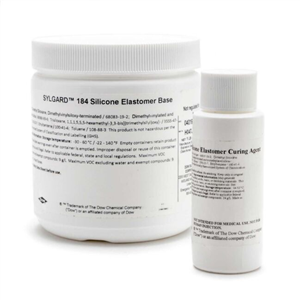

SYLG184
SYLGARD 184 Silicone Elastomer
2-part silicone elastomer, ideal for potting and encapsulating applications
This silicone elastomer has a very low dielectric constant sealing compound, which makes it ideal for patch clamping and many other lab applications, especially in electrophysiology applications.
- Overview
- Specifications
- Accessories
- Citations
- Related Products
Overview

There are 1 images available to view - click to enlarge and scroll through the product gallery.
SYLG184 IM
/ Download as PDF
SYLG184 Data Sheet
/ Download as PDF
SYLG184 SDS (UK)
/ Download as PDF
- Flowable transparent encapsulant
- Room temperature or heat cure
- Rapid, versatile cure processing controlled by temperature
- Good dielectric properties
- High transparency allows easy inspection of components
Curing Time
Curing Time: 24 hours at 25ºC, 15 min. at 150ºC
Details
A two-part Polydimethylsiloxane elastomerr, ideal for potting and encapsulating applications. Very low dielectric constant sealing compound used in patch clamping and many other lab applications. After cure, will withstand -55° to 200 °C.
Sylgard 184 silicone elastomer base and curing agent is supplied as a two part kit comprised of liquid components. When the base and the curing agent are thoroughly mixed in a 10:1 weight ratio, the medium-viscosity liquid mixture has a consistency resembling SAE No. 40 motor oil. The liquid mixture will cure in thick or thin sections to a flexible, transparent elastomer ideally suited for electical/electronic potting and encapsulating applications.
Sylgard 184 silicone elastomer offers a flexible cure schedule from 25-150°C, without an exotherm. Sylgard 184 silicone elastomer requires no post cure and can be placed in service immediately following the completion of the cure schedule at an operating temperature from -55° to 200 °C.
Sylgard 184 silicone elastomer is especially useful for applications where clarity is desirable. For more information, please refer to the manual.
Shipping Weight: 0.5 Kg
Specifications
Accessories
Citations
Szigligeti, P., Neumeier, L., Duke, E., Chougnet, C., Takimoto, K., Lee, S. M., … Conforti, L. (2006). Signalling during hypoxia in human T lymphocytes--critical role of the src protein tyrosine kinase p56Lck in the O2 sensitivity of Kv1.3 channels. The Journal of Physiology, 573(Pt 2), 357–70. http://doi.org/10.1113/jphysiol.2006.109967
Habets, R. L. P., & Verstreken, P. (2011). FlAsH-FALI inactivation of a protein at the third-instar neuromuscular junction. Cold Spring Harbor Protocols, 2011(4), pdb.prot5597. http://doi.org/10.1101/PDB.PROT5597




Request
Catalogue
Chat
Print